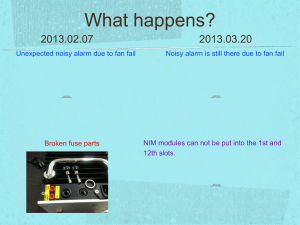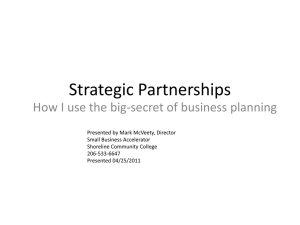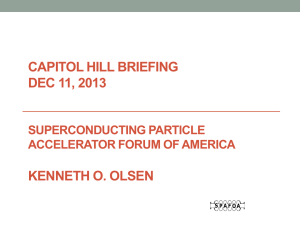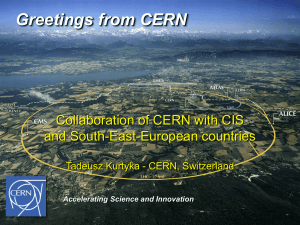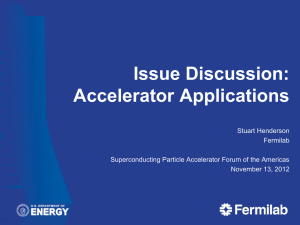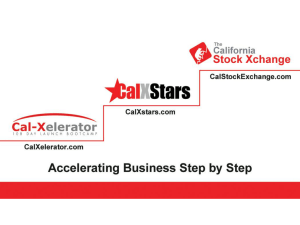PPTX - CERN Document Server
advertisement
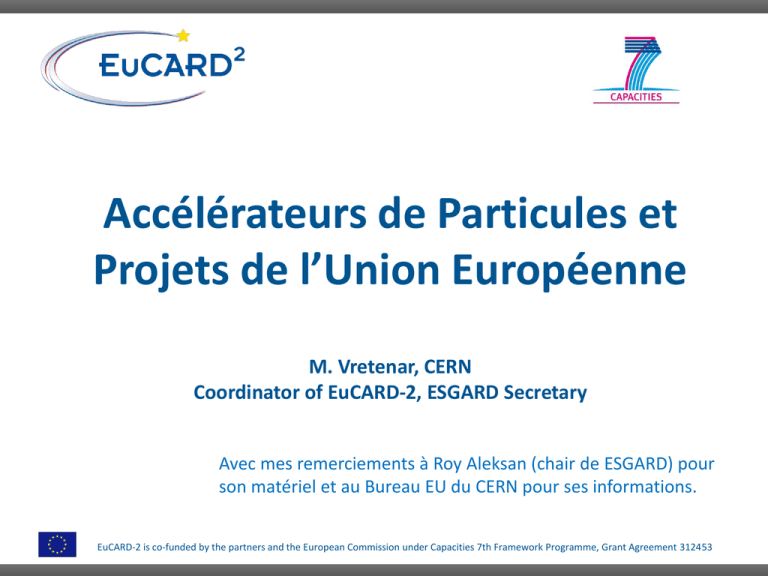
Accélérateurs de Particules et Projets de l’Union Européenne M. Vretenar, CERN Coordinator of EuCARD-2, ESGARD Secretary Avec mes remerciements à Roy Aleksan (chair de ESGARD) pour son matériel et au Bureau EU du CERN pour ses informations. EuCARD-2 is co-funded by the partners and the European Commission under Capacities 7th Framework Programme, Grant Agreement 312453 Horizon 2020 • After the different Framework Programs (FP, Programme Cadre PC) the new Horizon 2020 program has started in 2014 to cover the period until 2020. • the biggest EU Research and Innovation programme ever with nearly €80 billion of funding available over 7 years (2014 to 2020). Main keywords: coupling research and innovation, impact on society, build European Research Area. • Collects the previous FP7 (50 B€), CIP (Competitiveness and Innovation Program, 3.6 B€) and EIT (Eur. Inst. For Innovation and Technology, 0.3 B€) in a common program. Common funding scheme with structural funds for innovation and other funding schemes. H2020 Structure Of interest for accelerators From FP7 to H2020 FP7 H2020 Focus Research Research and Innovation Budget 55 billion € ~ 79 billion € Max. funding rate 75% 100% Overhead, ind.costs Different models 25% Time-to-grant 12 months (avg.) 8 months + some administrative simplifications Excellent Science European Research Council Frontier research by the best individual teams 13 268 Future and Emerging Technologies Collaborative research to open new fields of innovation 3 100 Marie Curie actions Opportunities for training and career development 5 572 Research infrastructures (including einfrastructures) (IA,DS, CNI-PP, ERA-NET…) Ensuring access to world-class facilities 2 478 Estimated Work programme 2014-2015 Budget: INFRA = ~580 M€, FET = ~450M€ Lifetime of a EU-supported RI project For each step, there are specific EC calls. Although amounts are small, for a new project is politically extremely useful to be integrated in the EC landscape EU and accelerators* *: only programs coordinated by the ESGARD committee, with particle physics as primary objective CARE 01/2004 – 12/2008 5 years, 15.2 M€ EU contribution EuroNu DS, 2008/12, 4M€ EuCARD 04/2009 – 03/2013 4 years, 10.0 M€ EU contribution ILC-HiGrade, 2008/12, 5M€ FP7 FP6 Integrating Activities Design Studies, Preparatory Phases EuCARD-2 05/2013 – 04/2017 4 years, 8.0 M€ EU contribution SLHC-PP, 2008/11, 5.2M€ TIARA-PP, 2011/13, 3.9M€ HiLumi LHC, 2011/15, 4.9M€ LABORATORIES: Infrastructure experience UNIVERSITIES: Intellectual potential, creativity Long-term R&D not a priority for large laboratories focused on short-term projects, INDUSTRY small institutions lack critical mass and the experience to be effective → a joint collaborative effort with the EU support is the most effective way to push the limits of our technologies. Long standing support, but budget shrinking (3 → 2.5 → 2 M€/year), more focus on networking and less on tecnological R&D. Supplemented by DS and PP (up to 4.5 M€/year in 2011). 7 Past and present accelerator projects by ESGARD FP6 FP7 EC contribution decreasing due to stronger competition, trend seems to continue in H2020 The Added Value of EU projects (in the words of the ESGARD chairman) EC projects have been and are instrumental: For fostering the community to carry out Accelerator R&D in a collaborative manner For enabling smaller institutes/universities to gain knowledge and experience by collaborating with large institutes and to access world class infrastructures For enabling coordinated and efficient means for a regionally balanced scientific and technological development. For triggering new ideas and developing further novel concept, e.g. crab waist scheme, plasma acceleration For allowing Europe to build expertise in domains where it was behind, e.g. Nb3Sn magnet, HTS links, PWFA… For helping improving accelerator R&D infrastructures, e.g. CTF3, SLS, SPARC, ICTF… For helping enabling the improvement or launch of large infrastructure projects, e.g. Linac4, LHC upgrades, FAIR, ESS ELBE, FLASH, XFEL, … The role of ESGARD ESGARD (http://www.esgard.org/) European Steering Group on Accelerator R&D. Established in 2002 by the directors of CCLRC, CERN, DAPNIA/CEA, DESY, LNF, Orsay/IN2P3, and PSI in consultation with ECFA. Present membership: R. Aleksan (CEA,Chair), M. Cerrada (CIEMAT), R. Edgecock (STFC), E. Elsen (DESY), S. Guiducci (INFN), M. Jezabek (IFJ)*, O. Kester (GSI), B. Launé (CNRS/IN2P3), K. Osterberg (HU)**, L. Rivkin (PSI), M. Vretenar (CERN, secretary). (*,**: represent Polish and Nordic consortia) Mandate: The ESGARD should develop a proposal to optimize and enhance the outcome of the Research and Technical Development in the field of accelerator physics in Europe by: • promoting mutual coordination and facilitating the pooling of European resources • promoting a coherent and coordinated utilization and development of infrastructures • promoting inter-disciplinary collaboration including industry. This proposal is also aimed at preparing and conducting a coherent set of bids to apply for EU funding through the Framework programmes established by the European Commission. From ESGARD to TIARA • ESGARD has been extremely succssful in its 12 year activity – promoting accelerator R&D projects but mainly fostering collaborations, structuring the community and creating a common approach to accelerator R&D. • Next comes TIARA (Test Infrastructure and Accelerator Research Area): a Preparatory Phase project defining the structure and governance for the establishment of the European Cluster of R&D Infrastructures for the European Accelerator Research Area. • TIARA should become a permanent structure replacing and strengthening ESGARD. Structuring a (successful) proposal • Integration of partners from different EU countries. • Identify scientific objectives (emphasizing societal and industrial impact), define the budget (ESGARD tradition: 50% matching funds from partners, could go up to 66% after negotiation phase), write and submit proposal. • ESGARD supports the preparation, evaluates the proposal and provides a recommendation that is forwarded to the EC. • Proposal is evaluated by a referee committee and possibly proposed for funding. • Funding is defined by EC, project enters negotiation phase (allocation can be 80% of request…). • Grant agreement signed, project can start. • During the project duration: deliverables and periodic reporting, financial audits. EuCARD-2 EuCARD-2 = European Coordinated Accelerator Research and Development, an Integrating Activity co-funded by the European Commission under the Capacity – Research infrastructure Program 48 months duration (01.05.2013 - 30.04.2017) 13 Workpackages (6 Networks, 2 Transnational Access, 4 JRAs) 40 beneficiaries (3 with 0 EU contribution) 14 countries (+ CERN) 23.5 M€ total cost (13.4 M€ direct costs, 10.1 M€ indirect+access cost) 8 M€ EC contribution (34% of total cost, 59.7% of direct cost) 1288 persons.month (average 8 pm/participant.year) 62 deliverables 86 milestones 13 EuCARD-2 objectives Scientific objectives: 1. Contributions to few R&D topics of excellence (high risk, high pay-off) on accelerators for research (HEP, nuclear physics, synchrotron lights, etc.). 2. Include new dimension of innovation, applications, relations with industry (healthcare, energy, environment, etc.). Political objectives: • For EU: strenghten collaboration and foster synergies, create a network of complementary scientific infrastructures, enhance EU competitiveness. • For large laboratories: attract partners into (long-term) projects, connect with high-level R&D, create a network of competences around the large laboratories. • For small Institutes: get access to big labs and to large scientific programmes, get the recognition (and the internal matching funds) related to EU projects. 14 2 Access to Research Infrastructures 6 Networks 13 Workpackages Extreme Beams – F. Zimmermann (CERN) Frontier performance of accelerators. Low emittance rings – Y.Papaphilippou (CERN), S.Guiducci (INFN), R.Bartolini (UOXF) Synergies synchrotron light sources, storage rings, damping rings, lepton colliders. Novel Accelerators – R. Assmann (DESY) European roadmap for plasma-based accelerators. Energy Efficiency – M. Seidel (PSI) Energy management in accelerators. Accelerator Applications – R. Edgecock (HUD) Accelerator technology for industry, health care, energy, ... Catalysing Innovation – G.Anelli (CERN), P.Woodman (STFC) Transfer to society of EuCARD-2 technologies. Ion Cooling Test Facility at STFC R. Preece (STFC) 4 Research &Technology Developments HighRadMat, MagNet at CERN A. Fabich and M. Bajko (CERN) Future Magnets – L. Rossi (CERN), P. Fazilleau (CEA) High Temperature Superconductors for 20 T magnets. Collimator Materials – A. Rossi (CERN), J. Stadlmann (GSI) New materials for future collimators. Innovative RF Technologies – P. Macintosh (STFC) High gradients for SC and NC accelerating cavities, RF diagnostics, photocathodes. Novel Acceleration Techniques – V. Malka (CNRS) R&D topics on plasma wakefield acceleration. An idea from EuCARD-2 WP4 Edit a brochure on “Applications of Particle Accelerators in Europe”, similar to the US one. Need international organising committee UK & CERN agreed, but need some other countries The EuCARD-2 partners 40 partners from 15 European countries, including Russia # 10 Short names Country % of EC CERN, CEA, CNRS, SOLEIL, Europe, France, 63% DESY, GSI, INFN, ESS, PSI, Germany, Italy, STFC Sweden, Switzerland, UK Technology Institutes and University departments in Applied Research 23 KUG, DTI, TUT, Grenoble INP, KIT, POLITO, WUT, UDUS, JGU, UROS, UM, UT, CSIC/VALENCIA, UU, UNIGE, HUD, RHUL, SOTON, STRATH, UCL, ULANC, UNIMAN, UOXF Scientific Institutes Industry 5 HZB, HZDR, NCBJ, NRC KI, Germany, Poland, 7% LUND Russia, Sweden RHP, BHTS Austria, Germany 3% Accelerator laboratories Research 2 Austria, Denmark, 27% Finland, France, Germany, Italy, Malta, Netherland, Poland, Spain, Sweden, Switzerland, UK 17 The Eucard-2 budget DenmarkRussia Finland 0.3% Spain 0.6% 0.3% Poland Sweden Austria 0.6% 2% Malta 2% 0% 0.3% Italy Switzerland 5% Project 5% Support 23% UK 13% CERN Netherlands 1% 13% France 14% Germany 20% Requested EU funding (8M€ in total) 18 New Design Studies • 3 Design Studies supported by ESGARD have been submitted on September 2nd. • Total budget for this call is 15 M€, maximum EC contribution 3 M€: only 5 to 8 DS can be approved. • Total of 39 DS proposals submitted (including a 4th one related to accelerators): competition is tough! • Ranking of projects expected beginning of 2015. • Somehow, EU is realizing that the DS budget was too low and foresees to increase for next call. Design Study proposals - 1 EuroCIRCOL (coord. CERN): core topics for a 100 TeV energy frontier hadron collider and feasibility study of its key technologies including infrastructure aspects, mode of implementation and estimation of the cost baseline. 4-years, 16 members, request contribution 3 M€. Only a sub-set of the Future Circular Collider activities, to support non-CERN participation. Design Study proposals - 2 EuPRAXIA (coord. DESY): European Plasma Research Accelerator with eXcellence In Application, prepare a CDR for a first plasma-based accelerator at 5 GeV and 2 user areas, compact femto-second FEL and HEP detector science. 4-years, 16 members, request contribution 3 M€. Only a sub-set of activities. ESSnuSB (coord. CNRS Strasbourg): evaluate the impact of a neutrino facility on the construction and operation of ESS (building up on the results of several previous EC projects). 3-years, 11 members, requested contribution 1.8M€. FET proposals FET = Future Emerging Technologies, new in H2020 FET Open funds projects on new ideas for radically new future technologies. Keywords: Long-term vision, Breakthrough S&T target, Foundational, Novelty , High-risk, Interdisciplinary 1st call 30/09/2014 Following calls 31/03/2015, 29/09/2015 2 proposals submitted via ESGARD, related to plasma acceleration (4-years, ~4M€ contrib.) 1. HiFLUX: High repetition rate Fiber Laser-Plasma accelerators for Ultrabright X-rays 2. Electron-Beam driven Plasma Acceleration «EuCARD-3» preparation • Integrating Activity Calls expected in 2014, 2016, 2018 and 2020. • New top-down approach: the EC invites selected communities to present a proposal; «Integration of research infrastructures for particle accelerator science and technology» is in the list of 19 high priority themes for Physical Sciences but was not invited in 2014 because EuCARD-2 is ongoing. • EUCARD-2 will finish in April 2017: we can expect to be invited to submit a new project for the 2016 call, starting in 2017. Maximum EC contribution 5 M€ can go up to 10 M€ for advanced topics. • Timeline: call expected in Autumn 2015, submission deadline mid-2016. • Procedure: by end 2014 ESGARD collects topics proposals from EuCARD2 TIARA and ESGARD partners, and from the AS&T community at large. • By early 2015 ESGARD nominates theme conveners in charge of developing a coherent theme package within specific budget guidelines. • By Autumn 2015: very first definition of the proposal. Will be soon circulated a small form to collect ideas and proposals for the next Integrating Activity (EuCARD-3 ?) Conclusions ESGARD and its supported projects are an essential forum to discuss define and implement common European strategies for the new generation of particle accelerators. These associative projects have been a necessary tool to establish collaborations, to develop new ideas and synergies and to share our R&D infrastructure. In this process, France is a central partner, present at an adequate level from the very beginning, mainly via its large research institutions. Back-up The EuCARD-2 Timeline January/September 2011 Project definition (on priorities set by ESGARD) September/November 2011 Nomination of coordinator, Project finalization 24.11.2011 Proposal submitted (10 M€ requested EU contribution) 08.03.2012 Evaluation Summary Report received: 14/15 30.03.2012 Favourable evaluation for funding, in stand-by for 2013 EC budget 16.07.2012 Invitation to negotiations received (8 M€ contribution) 27.08.2012 Negotiation meeting with EU officer 07.09.2012 Draft Annex1(reference document) submitted 19.10.2012 New version of Annex1 incorporating EC comments submitted 24.10.2012 Final Annex1 accepted by EC – end of negotiation phase 14.12.2012 All signed documents (Grant Preparation Forms) sent to Brussels 01.03.2013 Grant Agreement received from EU (after clearing technical details) 12.03.2013 Signed Grant Agreement sent to EU 22.04.2013 Signed Grant Agreement received from EU + autorisation 1st payment 01.05.2013 Start of the project 26

